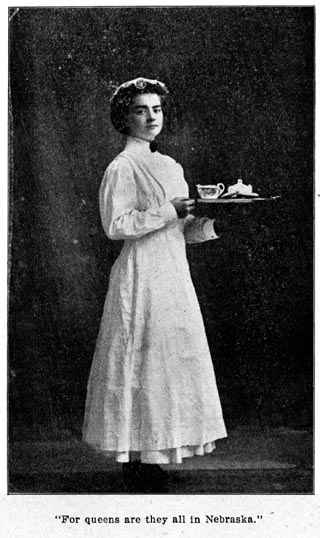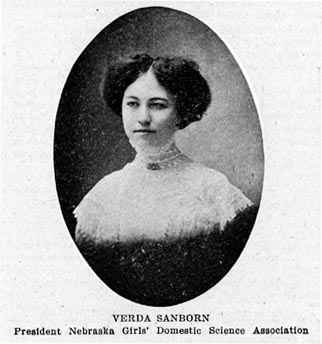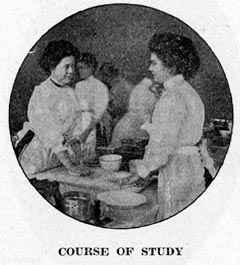
NEGenWeb
Project
Resource Center
Schools
|
112 |
|

|
|
113 |
The report of Ex-Superintendent J. L. McBrien for the preceding biennium gives an extensive review of industrial education up to the last biennium. The work has continued along the same lines during the present biennium, with a few additional features that have naturally come in the progress of the work. The membership in the Nebraska Boys' and Girls' Clubs has grown in the biennium from 20,000 to 32,000. Through the home experiment department several specific lines of work have been taken up which have been productive of good. An account of this work can best be given by presenting herewith a number of the bulletins issued In the interest of the work.
|
SERIES II. |
BULLETIN NO. 11 |
|
|
For Nebraska Girls' Domestic Science Clubs.
WHEN THE DAUGHTER GETS HOME FROM SCHOOL. |
||
|
"Soon as she turned in and got |
||
|
-James Whitcomb Riley, in "Home Folks." |
||
|
114 |
|
Herein is given our individual home work course In domestic science. The outline of lessons was originated and used first by the York high school girls' domestic science club, which held regular meetings once a week under the direction of Miss Rowan, one of the high school teachers. The work was done separately in the homes of the pupils. The results were such that the following year the board of education fitted up a domestic science laboratory, engaged a special teacher, and established the regular course of study in domestic science, open to all high school girls.
This outline has been successfully used by the domestic science clubs of the York, the Ainsworth, the Nebraska City, and the Beaver City high schools; the Woman's Club at Rising City, and the Women's Institutes at Harvard, Clarks, Clay Center, and other places. When used by women's institutes it is recommended that the girls be invited to participate and that they prepare and serve some of the dishes under the direction of some of the officers or the leader of the meeting.
The number of domestic science clubs has so increased, and there is such genera] demand for a course of lessons adapted to the individual home work plan, that this bulletin is issued especially to meet such needs.
The Plan. -- The plan of organization which has been very successful not only in high schools but in other schools, is as follows: The girls form a club limited in membership to only those who are especially interested in the subject and who, without neglecting the regular school work and their home duties can give a short but definite time each week to the work. A president and secretary are elected to look after the executive work and to keep the records carefully. A teacher in the school who is interested in the work and in the girls becomes the adviser of the club.
Meetings of the club are held once or, in some cases, twice a week, generally from 20 to 30 minutes In length, and held at a time when it will not conflict with the school work. Monday or Tuesday after the close of school, or at some time during school hours which does not conflict in any way with the school work, seems most convenient generally for clubs meeting once a week.
A certain recipe or direction is taken for the work each week and each member tries it at her home. Two, four or more members, or In small clubs, all the members are requested to bring results of their efforts to the next meeting for a special report, and all members are called upon to report results and make comparisons. Then a new recipe is taken, or a variation of the old one is tried for the next week. Thus, during the year a definite course of study is carried out.
Sometimes, luncheons for special occasions, Thanksgiving dishes, candles for Christmas time and other timely variations take the place of the regular lesson from the outline. Such variation is encouraged
|
|
115 |
that the club members may learn to prepare the things in which they are most interested and which are in demand locally at particular times.
While it is an advantage to have as director or manager of the club a teacher who Is familiar with the work in domestic science, it is not necessary that such be the case. Some of our best work has been done under the direction of teachers whose contribution to the success of the work was careful management and a spirit of learning with the members of the club.
After trying the recipes as given, club members are encouraged to vary recipes and directions as their originality may suggest and to develop any plan or direction which is different, and good. Members are requested to report any good things learned to the club and the club officers are requested to report the same to the state manager, who will give other clubs an opportunity to try them.
The outline is as well adapted for grammar grades and for older girls in rural schools as for high school students.

Domestic Science
Domestic science has a definite and proper place in curricula of
|
116 |
|
the public schools. In the Nebraska Course of Study for the elementary schools, domestic science is outlined, not as one of the five essentials, but as one of the general subjects to be interwoven with the regular work of the school.
As in the teaching of agriculture and manual training, domestic science should be correlated with the other subjects taught in the school so as to bring out the science and art of home making. It should show that the language, the drawing, the physiology, geography, physics, chemistry, and other sciences taught in the school may be best Illustrated from the every day home life of the pupil, and in such a way as to bring not only a good degree of right general education but so as to stimulate an interest and bring an enjoyment into the particular lines of activity in which the individual In the home should become Interested.
Such teaching will interweave the school life with the home life, will elevate the home, properly dignify the tasks connected therewith, and will vitalize the work of the school. The intelligent and skillful performance of any duty related to the interests of the home is right education at any period of the individual's development.

By Gertrude N. Rowan, University of Nebraska
The Purpose of Food
In the study of Domestic Science we think first of food, and the purpose of that food. Aside from eating because we are hungry, we
|
|
117 |
eat food to make us grow, to repair the waste, and to give us energy to keep warm and to work.
To do all this we need to take into
the body a certain amount of various kinds of food which will supply
the needs of the bones, muscles, brain, and all parts and organs of
the body. Some of this food we take in Its natural state just as it
grows. Some must be cooked to make it of good flavor and easy of
digestion. Some food may be taken either raw or cooked. Under
ordinary conditions, with the average person, the requirements of the
body demand seventeen ounces of solid food and five pints of water
each day.
In the first class are all those foods which possess or have possessed life. These are called the organic foods, such as meat, potatoes, flour, etc. In the other class are the inorganic foods, or those which do not contain organs of life, as water, salt, etc.
1. Proteids. Animal and vegetable foods which contain albumen in large amounts are called proteids. These are tissue builders. White of an egg is the purest albumen in this class. Other examples are milk, cheese, eggs, meats fish, cereals, peas, beans, and lentils.
2. Carbohydrates. The sugars and starches are called carbohydrates. They furnish the energy and maintain heat. They Include vegetables, fruits, cereals, sugars, and gums.
3. Fats and Oils. These store energy and heat to be used as needed. This class includes butter, cream, fat of meat, fish, cereals, nuts and olives.
1. Mineral Matter furnishes the salts.
2. Water makes up two-thirds of the weight of the body.
Before going to anything as complex as the composition of the body, let us study the air with which we are more familiar.
Air, which we cannot feel, taste or see, is made up chiefly of two elements: Oxygen and nitrogen. About one-fifth of it is oxygen and four-fifths nitrogen. There Is also a very little ammonia, sulphur gases, watery vapor, and carbon dioxide.
Here are some experiments which may be performed to show the composition of air.
Experiment 1. Drop a piece of ice into a glass of water. Notice the moisture collecting on the outside of the glass. From where does it come?
|
118 |
|
It does not come through the glass. The air around the glass Is quickly cooled and the moisture or watery vapor falls upon the glass. The same may be observed when the temperature falls. The moisture collects on objects in the form of dew or frost.
Experiment 2. Insert in the tightly fitted cover of a jelly glass a small lighted torch or wick several inches long. Watch it closely as it burns and finally goes out. What is the cause?
The oxygen in the air in the jelly glass is entirely used and the fire therefore goes out. Without the oxygen of the air, there would be no fire. Without the large proportion of nitrogen, fire would burn with a great explosion and too great rapidity.
Experiment 3. Put a piece of fresh lime about the size of an egg into a pitcher and upon it pour a small teacupful of water. When the lime has crumbled, pour a pint of water into the pitcher, stir thoroughly, let settle. Half fill a glass with the clear liquid. Using a straw or other tube, force the breath slowly through the lime water in the tumbler.
The clear water becomes turbid which shows there is carbon dioxide in the air from the lungs.
One-third of water is oxygen. It is united with two parts of hydrogen, and the symbol or sign representing water is H2O, or two parts of hydrogen and one of oxygen.
Just as air and water are made up of certain elements, the body Is also composed of different elements united in certain proportions. In the body there are 62 1/2 per cent of oxygen, 21 1/2 per cent of carbon, 10 per cent of hydrogen and 3 per cent of nitrogen. Three per cent is made up of the following: Calcium, phosphate, potassium, sulphur, chlorine, sodium, magnesium, iron, and fluorine.
After studying the composition of foods and the composition of the body, we can readily see that certain foods are of greater value to the body than others, and also that the needs of the body may be as well satisfied by the use of inexpensive foods as of the more expensive ones if they contain the proper amount of nutriment.
When we wish to heat a pint of water or keep it warm we kindle a fire under it. If we could arrange a thermometer under the kettle and measure the heat, we could tell just how much heat is required to make the water one degree hotter. This amount of heat is called a calorie.
The body must be kept warm. We know there is no fire to keep it heated, so there must be another method. In the body the food is the fuel, and as it is eaten and digested heat is produced. The heat of the body is measured just as the heat of the water was
 |
 |
 |
 |
|
© 2003 for the NEGenWeb Project by Ted & Carole Miller |
|||